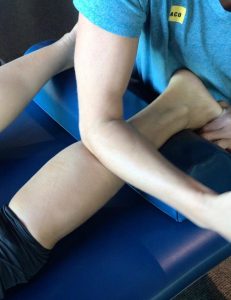
Starting physical therapy can be scary, especially if you’re in pain. Will it hurt more? How do I prepare? We always get these questions, and we’re here to help!
While we understand rehab can be intimidating, it can also be the beginning of an empowering journey. You and your physical therapist will work together to recover from your injury and learn how to prevent future injuries. You’ll work on improved flexibility, strength, body awareness, and coordination—and maybe you’ll discover that you’re mentally and physically capable of more than you once thought.
We listed five things to expect during a physical therapy evaluation, so you feel ready to tackle your injury head-on from the start. Prepare yourself, because we’re ready for you!
1. Intake Forms… They’re Important!
Intake forms are annoying, we know. They take forever to fill out, but they give us a lot of details that complement your physical evaluation. Just like your primary care physician (PCP), physical therapists use the information on your intake form to help create a treatment plan. They can also help us differentiate your injury from other possible conditions.
For example, if you’re attending physical therapy due to balance and frequent falls, we may screen your list of medications to see if they’re causing side effects like dizziness or low blood pressure that contribute to your symptoms. In this case, we may refer you to a pharmacist or your PCP to evaluate your medications while you see us.
There are also many systemic conditions, like heart problems or cancer, that can mimic muscle and joint pain. If you have a history of other medical conditions, we use that information to help us determine if you need additional tests. Although these conditions aren’t always common, they’re easily missed. An example would be kidney stones, which mimic low back pain due to the kidney’s location.
Make sure you have enough time to fill out our intake forms properly. Arrive 15-30 minutes early so you’re not in a rush.
2. A Chat About Your Symptoms and Lifestyle
Physical therapists don’t just focus on your specific injury, but on you as a whole person. JACO Rehab’s evaluations are between 50–60 minutes, and about 10 minutes alone are getting to know who you are, what you do, what’s important to you, and how your injury is interfering with your life. This also gives us information about your lifestyle, contributing factors to your injury, and key ways to help you progress during your day-to-day.
To prepare for our chat, think about these questions:
- What are your symptoms? What makes them worse or better? How did they start?
- How long have your symptoms been bothering you? Have you had a similar condition before?
- What do you do to alleviate your discomfort? How long does the relief last?
- Have you received physical therapy in the past? What worked for you?
- What does your day-to-day look like? Are there parts of your daily routine that you’ve had to change due to your injury?
- How are your sleep patterns? Do you get enough?
- What are your personal goals for physical therapy? Think specifically about this. What do you need to get back to? Do you have to lift a certain amount of weight daily, like carrying a baby or a backpack?
There is no detail too small. If it affects you, we want to know about it.
3. Movement and Measurements
Our main job is to fully understand your pain patterns so that we can help you develop a plan. To see your pain patterns, they need to be reproduced to some extent—our goal is not to send you into more pain, but we need to know where your limits are and measure them through a physical evaluation.
Don’t let this scare you away from treatment. You are in complete control through your communication. If we’re moving your arm over your head, you can tell us when pain is knocking on the door and we’ll measure at that point. If we ask you to stand and bend forward, you go as far as you’re comfortable and tell us your limit. Physical therapists need to gather starting measurements to determine if there’s progress as we go.
We test and measure:
- Joint mobility
- Muscle flexibility
- Strength
- Pain levels
- Balance
- Lifting capability
- In some cases, jump distance and timed activities
We use this information to understand what’s working, display progress as we go, and document for your doctor and insurance. We re-measure during each visit.
4. Treatment on the First Day
Once we know more about your injury from our chat and our physical evaluation, we start paving a path forward. We find ways to alleviate pain within the session. Sometimes soft tissue manipulation, similar to a massage is helpful in relieving trigger points within muscles. A physical therapist may also employ other techniques to help you start moving better right away.
- Soft tissue manipulation on the calf
With most injuries, you’ll also start performing exercises on the first day. They aren’t meant to be painful, but instead, relieving. You may feel sensations of stretching, pulling, or muscle burn (from exercise), but never pain during the activity. If you feel pain, make sure you communicate with your therapist. They can help find a different activity that works for you.
You’ll also receive advice on things to avoid for the time being, if appropriate. For example, if you have an overuse injury from running, you may have to decrease mileage until you can tolerate ramping up activity again. Talk to your physical therapist to see how you should modify your daily routine for the time being and complement your rehab.
5. Homework
You heard us right! You’ll have homework on the first day, called your home exercise plan (HEP). We hit the ground running to get you better as fast as possible.
Your HEP may be as simple as taking a 10-minute break from sitting at work each day to help alleviate back pain, or it could be 2–3 exercises designed to relieve pain and start strengthening supporting musculature. Your homework depends on your evaluation, your injury, your capabilities, and what your therapist deems appropriate for you. Every person is different, so you may receive a different set of activities from a person with the same injury.
It is extremely important—and expected—that you perform your homework as prescribed. Just like taking medication from your PCP, your HEP helps you get better. You only see us for two hours per week, so you need to continue treatment on your own to reach your goals. Read more about how you can make the most out of your physical therapy sessions.
Also, your therapist can tell if you didn’t do your homework! If there is no progress between sessions, or if you forget your prescribed HEP during the session, it’s hinting to us that you didn’t perform it. Remember that insurance will only approve a certain amount of sessions per prescription, so you must stay committed to your rehab to take full advantage of your approved sessions.
Note that more is not more. Overdoing your HEP is just as detrimental to your progress as not performing it at all. Your HEP is specifically designed to complement your current stage of rehab, and doing more than what is prescribed could cause an overuse injury. If you’re unsure about your scheduled homework, ask your physical therapist to clarify.
Reach Out!
We hope this list helps you understand what’s to come! We’re excited to meet and treat you. If you have any further questions, don’t hesitate to reach out to JACO Rehab at 808-381-8947.
Written by Nicole Hernandez, DPT

